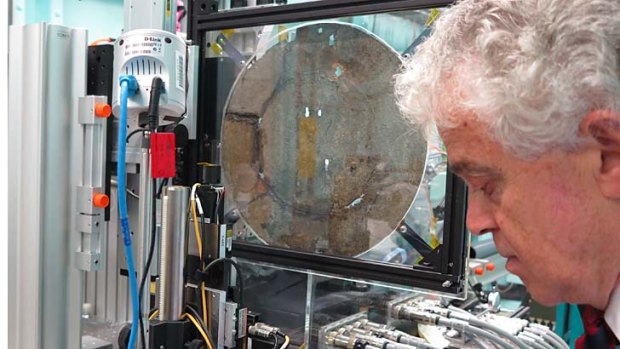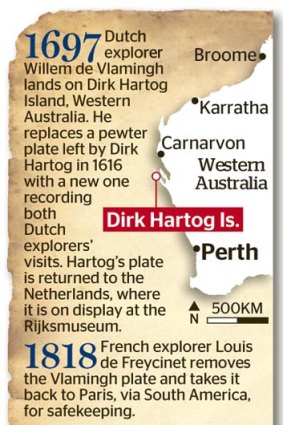By Bridie Smith
The story behind one of Australia's earliest records of European contact has been revealed after a team of scientists unravelled the mysteries hidden in a historic pewter plate.
First nailed to a post on a remote West Australian island by Dutch explorer Willem de Vlamingh in 1697, the battered plate withstood 121 years of exposure before French explorer Louis de Freycinet removed it for safekeeping.

WA Museum's Dr Ian MacLeod near the plate as it was installed in the beam line at the Aust Synchrotron in Clayton.
The plate was taken to France, where it lay forgotten in a Paris storeroom for over a century. Rediscovered after World War II, it was returned to Australia in 1947 as a gesture of goodwill.
Now, using the Australian Synchrotron's intense, high-energy X-rays and a digital microscope at the National Gallery of Victoria, scientists have unravelled the 300-plus-year-old plate's story – which includes surviving a shipwreck and being blasted by a cyclone.

"Some people may think it's just a lump of metal but the point is you can read it," said Ian MacLeod from the Western Australian Museum, where the plate has been stored since the 1950s. "It tells quite a story."
Known as the Vlamingh plate, the fragile piece of pewter started its life as a bowl before being flattened to serve as a plate that is 35 centimetres in diameter.
Working with the NGV's senior conservator of metals and conservation science, David Thurrowgood, Dr MacLeod said the fine scrape marks left inside the bowl by cutlery became evident under the gallery's digital microscope.
But it was the detail uncovered using the Australian Synchrotron that paints the best picture of the plate's time exposed to the elements on remote Dirk Hartog Island, 830 kilometres north of Perth.
The synchrotron images reveal uneven lead distribution in the plate and areas where rectangular iron nails used to fasten it to a post had corroded some of the lead content.
"In the synchrotron images you can see a series of weeping lines, so the iron corrosion products ran down the plate in the damp moist air," he said. "They reacted with the lead in the pewter and dissolved it."
Looking at the plate as if it were a clock face, the side of the plate between one and five o'clock was revealed to have had depleted lead. This was the edge that faced the sea.
A series of radiating lines between six and eight o'clock indicate that after the plate was hung, it slipped to an angle of 23 degrees, 25 degrees and 27.5 degrees before the post fell over.
Before it fell, a grain of sand lodged in the back of the plate, probably during a cyclone.
"That tells us that the probable cause of the initial collapse or the bending of the plate was due to a cyclone," Dr MacLeod said. "It would have had to be incredibly powerful winds to bed a sand grain into a metal structure."
The timber post – a piece of Rottnest Island pine – also leached acetic acid onto the back of the plate as the timber decayed. This eroded the lead in the pewter.
"All this detail about the corrosion processes was totally unexpected. I've been blown away by it," Dr MacLeod said, adding that the plate was now very fragile.
A metal conservator, Dr MacLeod said the work was vital to maximise conservation efforts. While the plate was pewter, its composition was a mystery. The degree to which time and the harsh environment had weakened the structure needed to be understood, if the plate was to be properly conserved.
Establishing its condition was also vital before releasing it for travel to planned interstate and overseas exhibitions.
"This is really important," Dr MacLeod said. "Unless you know the composition of the alloy and how it's decayed, you can't work out the best way to conserve it."
The plate is planned to be part of an exhibition at Canberra's National Library in October.
It will also appear in Perth as part of an exhibition for the 400th anniversary of Dirk Hartog's arrival in Australia in 2016, which is expected to travel to the Netherlands.